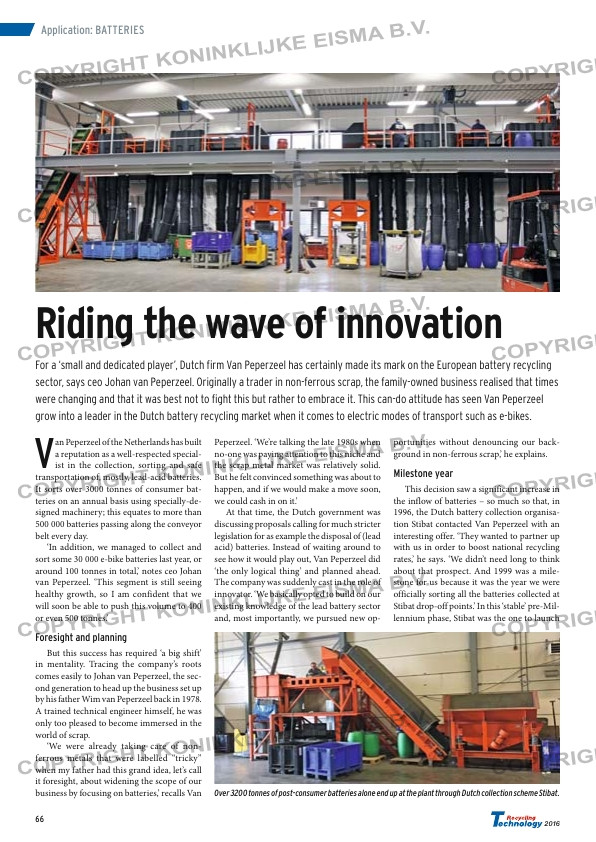Page 64 from: Recycling Technology 2016

66
2016
Application: BATTERIES
Riding the wave of innovation
For a ‘small and dedicated player’, Dutch firm Van Peperzeel has certainly made its mark on the European battery recycling
sector, says ceo Johan van Peperzeel. Originally a trader in non-ferrous scrap, the family-owned business realised that times
were changing and that it was best not to fight this but rather to embrace it. This can-do attitude has seen Van Peperzeel
grow into a leader in the Dutch battery recycling market when it comes to electric modes of transport such as e-bikes.
V
an Peperzeel of the Netherlands has built
a reputation as a well-respected special-
ist in the collection, sorting and safe
transportation of, mostly, lead-acid batteries.
It sorts over 3000 tonnes of consumer bat-
teries on an annual basis using specially-de-
signed machinery; this equates to more than
500 000 batteries passing along the conveyor
belt every day.
‘In addition, we managed to collect and
sort some 30 000 e-bike batteries last year, or
around 100 tonnes in total,’ notes ceo Johan
van Peperzeel. ‘This segment is still seeing
healthy growth, so I am confident that we
will soon be able to push this volume to 400
or even 500 tonnes.’
Foresight and planning
But this success has required ‘a big shift’
in mentality. Tracing the company’s roots
comes easily to Johan van Peperzeel, the sec-
ond generation to head up the business set up
by his father Wim van Peperzeel back in 1978.
A trained technical engineer himself, he was
only too pleased to become immersed in the
world of scrap.
‘We were already taking care of non-
ferrous metals that were labelled “tricky”
when my father had this grand idea, let’s call
it foresight, about widening the scope of our
business by focusing on batteries,’ recalls Van
Peperzeel. ‘We’re talking the late 1980s when
no-one was paying attention to this niche and
the scrap metal market was relatively solid.
But he felt convinced something was about to
happen, and if we would make a move soon,
we could cash in on it.’
At that time, the Dutch government was
discussing proposals calling for much stricter
legislation for as example the disposal of (lead
acid) batteries. Instead of waiting around to
see how it would play out, Van Peperzeel did
‘the only logical thing’ and planned ahead.
The company was suddenly cast in the role of
innovator. ‘We basically opted to build on our
existing knowledge of the lead battery sector
and, most importantly, we pursued new op-
portunities without denouncing our back-
ground in non-ferrous scrap,’ he explains.
Milestone year
This decision saw a significant increase in
the inflow of batteries – so much so that, in
1996, the Dutch battery collection organisa-
tion Stibat contacted Van Peperzeel with an
interesting offer. ‘They wanted to partner up
with us in order to boost national recycling
rates,’ he says. ‘We didn’t need long to think
about that prospect. And 1999 was a mile-
stone for us because it was the year we were
officially sorting all the batteries collected at
Stibat drop-off points.’ In this ‘stable’ pre-Mil-
lennium phase, Stibat was the one to launch
Over 3200 tonnes of post-consumer batteries alone end up at the plant through Dutch collection scheme Stibat.



